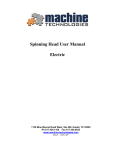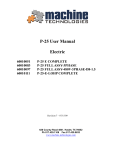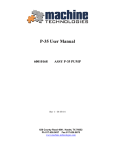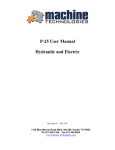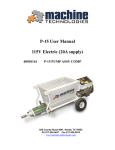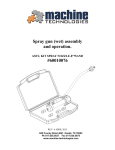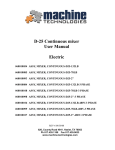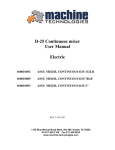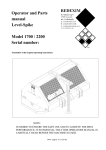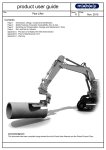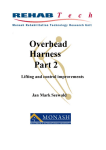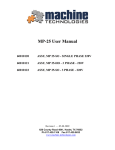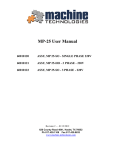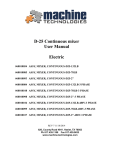Download Spinning Head User Manual Electric, with integral Winch supply
Transcript
Spinning Head User Manual Electric, with integral Winch supply 620 County Road 4841. Haslet, TX 76052 Ph 817.439.1108 Fax 817.439.0633 www.machine-technologies.com Rev4 – 12/16/08 Dear Customer, Before starting this machine please complete the following; Machine Date of purchase………………………………….. Machine serial number……………………………………… Please read the following information contained within this manual and fully familiarize yourself with the equipment. Page 1 Contents Page Section 1 - General Safety information........................................................................... 3 Danger ............................................................................................................................ 3 Section 2 - Machine Description ...................................................................................... 4 Function.......................................................................................................................... 4 Machine illustrations..................................................................................................... 5 Basic Spinning head ................................................................................................... 5 Exploded view of full machine .................................................................................. 6 Control box and mount.............................................................................................. 7 Control box assembly to support .............................................................................. 7 Control box assembly to support .............................................................................. 8 Control box assembly to support .............................................................................. 9 Section 3 –Typical positioning ......................................................................................... 9 Section 3 –Typical positioning ....................................................................................... 10 Section 4 – Machine set up ............................................................................................. 11 Unpacking .................................................................................................................... 11 Machine adjustments .................................................................................................. 12 Shim adjustment....................................................................................................... 12 Blade replacement.................................................................................................... 13 Section 5 – Machine operation / cleaning / maintenance ............................................ 14 Notes for operation ...................................................................................................... 14 Operational photo........................................................................................................ 16 Notes for cleaning ........................................................................................................ 17 Important notes for maintenance............................................................................... 18 LIMITED WARRANTY POLICY .............................................................................. 21 Page 2 Section 1 - General Safety information Danger Follow these instructions very carefully, in order to avoid injury to yourself or others. Always ensure that all power to the machine has been turned off and isolated before ANY maintenance / repair work is carried out on the machine. Each of the power cords fitted to the control box, MUST be fed via a separate circuit to prevent overload of a standard 15 A supply. Ensure that all guards are correctly fitted before starting or attempting to operate the machine. Ensure that all fasteners are present and correctly fitted before attempting to start or operate the machine. Ensure that the rotating head on the end of the unit is correctly fastened, free of damage and able to rotate freely, without collision, before attempting to start or operate the machine. Ensure that the rotating head on the end of the unit rotates freely and true, if not then DO NOT operate the unit The spinning head produces high RPM on a heavy spinning plate with diffuser blades, which can be dangerous. Care must be taken by authorized persons when using and working with this machine. DO NOT turn the unit on without it being correctly fastened to the tripod and winch assembly, together with a hose attached to provide stability against the torque reaction during start up. DO NOT start the machine at any speed setting other than LOW, or the unit will “twist” around causing damage to the unit, the mountings and possibly injury to the operator. NEVER run material through the spinning head without the unit being within a collection devise, or injury can result from flying material. ALWAYS run the mortar pump at the lowest possible speed to do the job, to avoid pressurization of the spinner and bearing damage. ALWAYS grease the unit (see notes later in this document) prior to storage and after clean up. Always perform a “clean up” between manholes. Ensure that ALL material is removed from within the Nylon housing and around the drive shaft. Page 3 Section 2 - Machine Description Function The Spinning head has a drive motor, that turns a drive shaft within a Nylon housing that in turn rotates the rotating head fitted with diffuser blades. The drive motor is a 90V DC unit rated at 1HP @ 2500 RPM. Material is fed into the spinning head from a low pressure line into the side of the Nylon housing, via an adapter and a removable elbow, which then is redirected, axially, through the front of the unit out towards the spinning end plate. Centrifugal force from the rotation then causes the material to be thrown out and up away from the machine, allowing the coating of the surfaces to repaired. The motor is powered by a variable speed DC motor controller, which is equipped with a number of trim pots allowing the setting of; Maximum motor speed. Minimum motor speed. IR Compensation, to minimize load speed changes. Current limit, limiting the max armature current. Acceleration, controlling the rate of speed increase. The rotating head is equipped with replaceable blades and removable shims, allowing for adjustment due to wear caused by material Page 4 Machine illustrations Basic Spinning head 1 – Main body 2 – Nylon housing 3 – Rotating head 5 – Blade fixing bolt 6 – rotating head fixing bolt Page 5 4 – replaceable blade 7- lifting eye Exploded view of full machine Page 6 Control box and mount Page 7 Page 8 Control box assembly to support Page 9 Section 3 –Typical positioning The machine is typically manually transported around the job site. The spinning head is designed to be slung from a winch unit, that is, itself supported from a tripod. Page 10 Section 4 – Machine set up Unpacking Consult the final inspection record supplied in the packing for details of your machine and the items checked prior to shipment. Keep this document for your records. The spinning head requires assembly to the drive unit, the tripod, the winch, the DC speed control. The Spinner DC speed control uses regular 115VAC power cord, the Winch PSU outputs at 12DC and requires a regular, but separate 115VAC supply. Both supplies should be individually fused at 15A and on individual breakers / supplies. Ensure that all cable connections are secured prior to connection to the power source. Do not make and break connections when the unit is powered up as severe damage will result to the drive unit Page 11 Machine adjustments Shim adjustment During normal use the diffuser blades will wear, allowing the gap between the blades and adjacent nose cone to increase reducing the slinging capabilities of the unit. To reduce the gap, the rotating head must be removed, using a 3 leg puller with three ¼20 threaded legs, after removing the main fixing bolt. Adjust the number of shims used, to obtain the correct performance with the chosen material. Retain all shims for later use. If the wear is sufficiently high that there are no more shims to be removed, then the blades will need to be replaced. Page 12 Blade replacement The removal of the rotating head is the same for the shim adjustment as it is for the blade replacement. Once the head has been removed, then the blades can be removed, and replaced in a full set of three. Replacement of the head will now require that the previously removed shims need to be replaced to lift the new blades from the cone face Page 13 Section 5 – Machine operation / cleaning / maintenance Notes for operation • • • • • • • For starting the spinner, ensure that the speed control is at minimum. Set up tripod over manhole. The legs lock into place when pulled out. Level the tripod buy pulling the pins in the legs. The pins have a push pin in the head to release them. Install the winch in the slot on the underside of the tripod head. Install the keeper pin through the holes that align with the winch. Install the safety pin into the keeper pin. Winch should be level. Attach the spinning head onto the safety hook on the winch. Connect the 2 separate 110VAC plugs to the individual power sources. Make sure both switches on the control box are in the OFF position before making connections. Connect cords with cable the square 4 pin connectors to control box and to spinning head. Once the winch assembly has been secured under the tripod, then the control box and hanger can be assembled to the winch support, using the supplied linch pin. Ensure that no power is connected to any part of the control box, and assemble the winch power cables to the binding posts on the side of the control box, ensure that RED lug is fitted to the RED colored post, and the BLACK lug to the BLACK colored post. • • • Connect the winch DC power cables to the control box Turn main power connection to ON. Move winch power switch to ON for the winch and observe the switch to illuminate. Page 14 • Connect the winch remote to the winch. . • • • • • • • • • • • With the spinner turned OFF, lower the spinning head into the hole to the base. Raise by at least 6” (or as required), and mark the cable at the drum. This marking is used to ensure that the spinner NEVER touches the bottom of the hole during operation. Severe damage can result if the touches the base during operation, such as bent shaft and bearing damage. The Spinning head must be stabilized, via by hand or by attaching mortar hose, before turning on power. Spinning head will twist cable and cords causing damage and or electrical hazard without stability. NEVER touch the rotating head when testing or running unit. Ensure that the spinner speed knob is fully Counter Clockwise. Switch the spinner on /off switch to ON Slowly increase the speed until set to maximum (Always use maximum, and adjust pump rate to suit, not adjust the spinner or plugging may occur). Lower unit into manhole using the winch control, so that material will not fly out. Start the mortar pump unit at minimum speed to feed material to the spinning head and start to lower into the hole. Adjust material flow using pump speed until a smooth flow of material is flying from the spinning head. (see photo of operation). DO NOT pump excessive material into the spinner or pressurization will occur damaging the seals and invalidating any and all warranties. Cycling the spinner up and down inside the manhole while doing this adjustment will prevent excessive material build up in one place. Continue lowering unit towards bottom of hole. Do not let unit touch bottom of hole (look for the cable marker to appear on the drum). Raise unit back to top of hole. Continue until walls are evenly coated. (approx 5 – 6 passes should provide approx ½” coverage). The mortar hose and power cable need to be attended to on the up and down travel to keep them from twisting. Page 15 Operational photo Page 16 Notes for cleaning • • • • • • • • • When a hole is complete, the spinning head must be cleaned. Remove from winch, unscrew elbow on mortar inlet and flush with water using a high pressure lance (DO NOT focus the jet towards the seal area). Completely wash out mortar cavity and cup on bottom of unit. When cleaning use a high pressure water jet into the mortar inlet in the Nylon body. Remove the elbow fitting, LEAVE the reducer in place (apply grease to the threads of the elbow at re-assembly to make later removal easier) The removal of ALL material from within the Nylon housing and from around the drive shaft is critical, to prevent early failure of the front seal and then bearings. It is recommended that between holes, that the bearing be greased with 1 slowly applied pump of grease, without the removal of the grease vent port. The unit is ready for the next hole. To break down tripod remove the load on one a leg at a time, pull down on each of the legs and they will fold inward. Do not spray water on or in control box. Control box should be cleaned by being wiped down with a damp rag or cloth ONLY. NEVER spray water onto the control box from any direction Be careful of the control box, the fan enclosures at the top and the bottom are easily damaged. Page 17 Important notes for maintenance Grease to be used is No.730-2 Multipurpose grease, High temp, non-corrosive, extreme pressure, anti-wear, water repellent, high resist to water, steam, acids and detergents. White in color. • • • At the start of each job the unit should be greased, per the following instructions. At the middle of the day the unit should again be greased, per the following instructions. At the end of the day the unit should be greased, per the following instructions. Greasing the unit is a simple yet critical part of the use and maintenance of the spinning head, as the grease physically keeps the material from entering into the bearing seal and bearing cavity. Failure to perform this task correctly WILL result in bearing failure. • • • • • • Clean both the grease nipple hole, the nipple and the grease vent hole. Remove the grease vent set screw using a 3/16” hex key. Assemble the grease gun to the nipple and pump grease until clean grease freely flows in a constant stream from the vent hole, at the same time the rotating head should be manually turned. If the existing grease is not the same color as the grease being pumped in, then this indicates that material is entering the bearing through the seal, and bearing failure is imminent. Replace the grease vent set screw, and lightly tighten down. Note do not over tighten, or damage to the housing and or thread will occur. Turn the rotating head manually and SLOWLY apply one to one and a half additional pumps of grease, through the grease nipple, grease will be heard to pass the front seal into the motor cavity. Page 18 During each greasing operation, the free spinning of the rotating head should be checked, feeling for signs of potential ingress of material into the bearing assembly, such as rough rotation, the feeling of intermittent rotation, and or “grinding” in the bearings. If any of these symptoms are felt then operation should stop and the unit returned for repair. Page 19 • In the event that the spinner bearings start to fail it is quite possible that the power supply will become overloaded, and the re-settable fuse could trip. If this happens, Turn off all power and disconnect from the supply, locate the 15A reset button (see photo below) and press the top until a click is heard and the fuse becomes reset. • In the event that the winch stops functioning, check to see if the light is illuminated on its switch, if the light is out then it’s possible that the circuit has been over loaded and has tripped. Locate the 5A trip and reset as above. • Note. There are no user serviceable parts inside the control box. For every “trip” or fuse failure there is a reason, such as bearing failure, winch motor over heat, spindle damage, spinning head damage, water ingress, cable damage, snagged cords or cable etc. etc. ALWAYS INVESTIGATE THE REASON FOR THE SYSTEM OVERLOAD NEVER “JUST CARRY ON” OR YOUR EQUIPMENT MIGHT SUFFER FURTHER DAMAGE! The winch PSU is self protecting and self resetting. In the event of an over load the unit will shut down, requiring the power to be turned off and re applied prior to the unit becoming functional again. The winch is able to operate for a maximum period of 20 minutes at a time while cycling the spinning head up and down, during which time the winch motor will become hot (up to 200 degrees F) this is normal. Temperatures above this should be avoided or damage to the winch motor can occur. The winch is an intermittently rated device, spray of manhole is intermittent by nature. Do not run the winch continuously or damage will occur. Page 20 LIMITED WARRANTY POLICY Machine Technologies warrants each of its new machines to be free of defects in material and workmanship under normal use and services for a period of one (1) year from the date of delivery. The warranty is issued ONLY to the INITIAL USER. The warranty period begins when the product is delivered to the initial user or when first put into service, whichever occurs first. Said warranty is void if the machine is subject to misuse, neglect, accident or abuse. Machine Technologies’ obligation under this warranty is limited to correcting without charge, at its warehouse, any parts or parts thereof which shall be returned to its warehouse, transportation/shipping prepaid and upon Machine Technologies’ examination proves to have been originally defective. Correction of such defects by repair or replacement shall constitute fulfillment of all obligations to the initial user. This warranty does not include labor or transportation charges unless specifically identified and authorized in writing by Machine Technologies. Nor does the warranty apply to any unit upon which repairs or unauthorized alterations have been made. The warranty does not apply to normal maintenance service or to normal replacement of certain machine parts which are subject to normal wear (including but not limited to pins, bushings, rotors, stators, hoses, spray caps, spray nozzles, mixing shafts, shaft couplings and connectors, dosing shafts, pump shafts, filter elements and tires). THIS IS A LIMITED WARRANTY AND IS IN LIEU OF ANY OTHER WARRANTIES, EXPRESSED OR IMPLIED, INCLUDING ANY WARRANTY OF MERCHANTABILITY OF FITNESS FOR A PARTICULAR PURPOSE. In no event shall Machine Technologies be made liable for incidental, general or consequential damage, loss or any expense directly or indirectly related and resulting from use or lack of use caused by delay in delivery, parts failure, or any other causes associated with the product use. No person, firm or corporation is authorized to assume for Machine Technologies any other liability in connection with the sale of Machine Technologies products. Page 21























